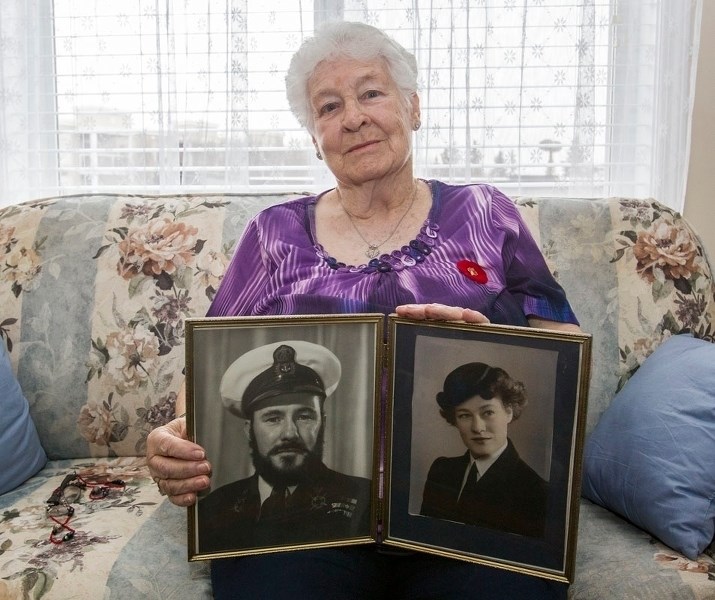Vera Bruce, 93, lives a quiet life in St. Albert’s River Ridge seniors’ residence and few might guess that from 1942 to 1945 she was a petty officer in the Royal Navy working on radar, which at the time was a new science and was considered ultra-secret.
Sworn to secrecy, even now Bruce has trouble revealing the work she did.
“We had to sign the official secrets act. Radar was installed in ships and planes and it was very new. In fact sonar wasn’t developed until after the war started. Everyone had different systems, but as far as I know the Germans didn’t have knowledge of the radar system we used,” Bruce said.
When the Second World War began, Bruce’s work with the government was considered an essential service. At the time she lived in Bradford, in Yorkshire, England. During the day she worked as a clerk. At night, she volunteered with the Women’s Auxiliary as a firefighter.
“We would go up on the roof with these little buckets. Our job was to put out the fires during air raids,” Bruce said.
In 1942 government regulations changed allowing Bruce to join the navy.
“I jumped at the chance. I was 21 and I was given permission to join the WRENS (Women’s Royal Navy),” Bruce recalled.
Bruce was sent to London for a two-week probation period and put to work scrubbing floors and stairs.
“If we didn’t like it, we could go home. If they didn’t like you, you were sent home,” she said, recalling the time a senior officer asked her to scrub the “portholes” even though they were inside a building.
“I looked at her and asked, ‘What portholes?’ and she said, ‘The windows of course!’’
Bruce chose to be a radar mechanic, which meant six months of study for a basic electrical engineering program.
The pass mark for the weekly exams was 60 per cent, and a fail meant instant dismissal.
The studying was endless and though Bruce was living together with 26 other young women, there was little fun. Curfew was 10 p.m. on weekdays and 11 p.m. on weekends and the WRENS’ commanding officer was strict.
“She told us, ‘I am responsible to your mothers,’” Bruce recalled, as she explained that onboard, her uniform was bell-bottom trousers, because skirts were not allowed on the ships.
There were nightly air raids by the Germans.
“Every night the bombers went up the river and there was no bomb shelter (nearby). So when the sirens went off, we’d take a pillow and blanket and head out into the hallway, so we would be protected from the glass,” she said, adding that despite the noise and fear, her fellow students were usually calm.
“There was no screaming. It was part of life. Wars are very cruel things and the air raids were terrible. There was nothing you could do about it. Just try to get to sleep because you had an exam the next day.”
Bruce worked for some months on the radar sets on seaplanes before taking a second course that allowed her to work on ships. After graduation, she and her friend Mary took a weekend’s leave of absence before heading to their next posting in Great Yarmouth. That meant they missed a terrible war disaster.
“We were in London when the Wrennery in Great Yarmouth was bombed killing some of the WRENS,” Bruce said.
The WREN motto was “Never at sea,” and Bruce was not allowed to leave the harbor when she worked. For the most part, she went onto the ships alone after they came back following a night of looking for German boats. Then she would calibrate and tune-up the radar.
“The torpedo boats were camouflaged. In winter they were blue and white. In summer, pink and mauve because they would go out at sunset and come back at dawn. Their job was to hunt for German e-boats and shoot them,” Bruce said.
The radar equipment Bruce worked on was so secret the British armed some of the devices so that the enemy could not figure out how they worked if the ships were captured.
“They were top secret. If anyone interfered with the radar, they would self-destruct. They didn’t blow up, but they had a mechanism to melt them if they weren’t handled properly. You had to work very, very carefully, ” Bruce said matter-of-factly, as if every 21-year-old girl would know how to work around such detonating devices.
Bruce spent the last year of the war on the Isle of Man and that’s where she met her husband-to-be, Jack. They married in 1945.
“He was Canadian. He was in navigation. He worked on sonar and radar in the North Atlantic. Following the war he stayed in the navy for 26 years and then he was in oceanography,” Bruce said.
Bruce became a war bride, and as she put it, “Looked after her family and raised her children.” The Bruces lived in Halifax and Kelowna. Twelve years ago, after Jack’s death, she moved to St. Albert to live near her daughter.
Nothing in her early years prepared Bruce for her war service as a firefighter and then as a radar mechanic, but she is proud of the part she played. She still has a photo of herself and her husband, in uniform, which she places on a small table in her living room. She is well aware that she was part of something historically significant, which was scientifically new in those days. She recalled she had never even heard the word “radar” until she joined the Royal Navy.
“It was so exciting. It was something out of this world,” Bruce said.



